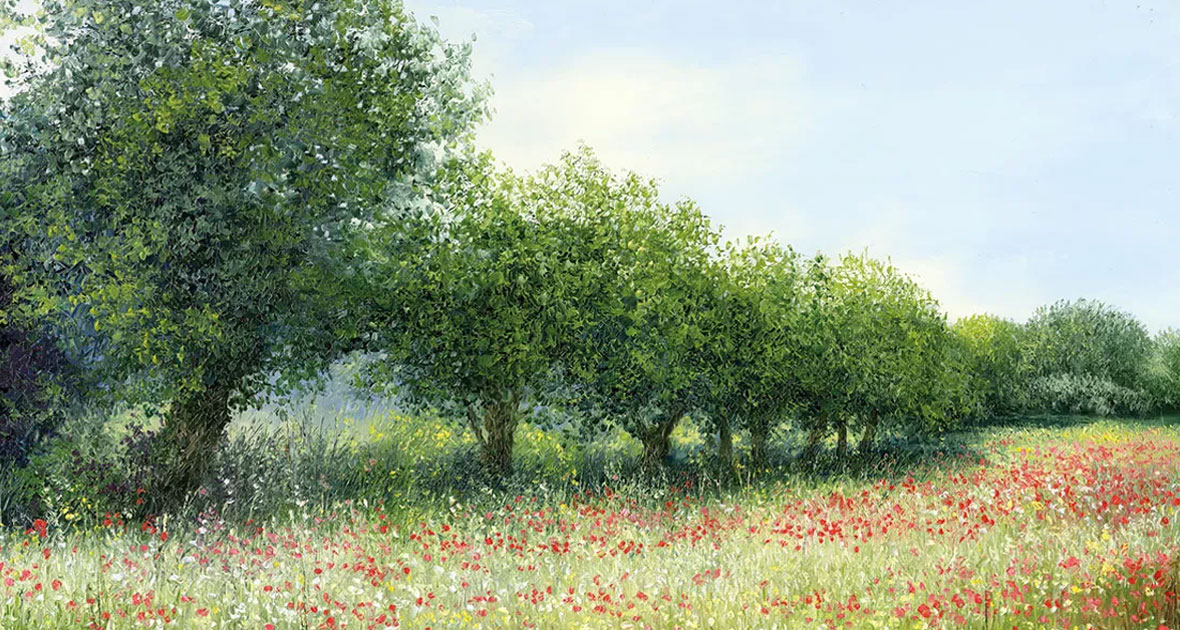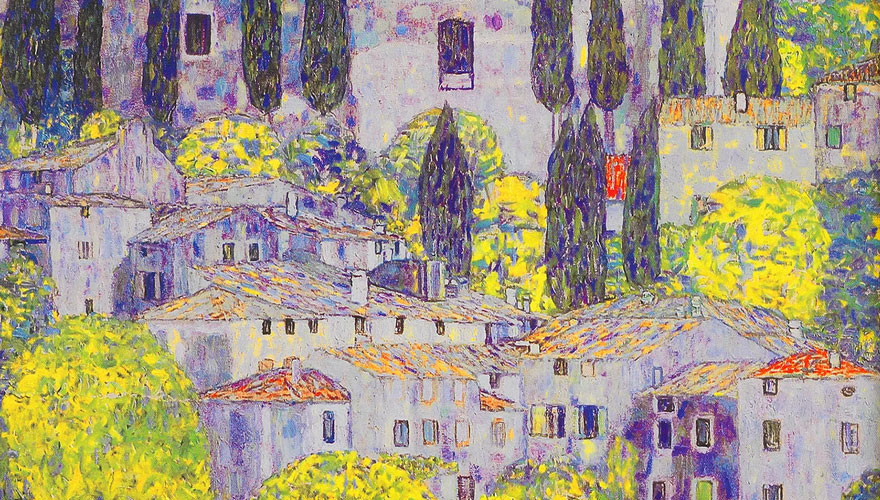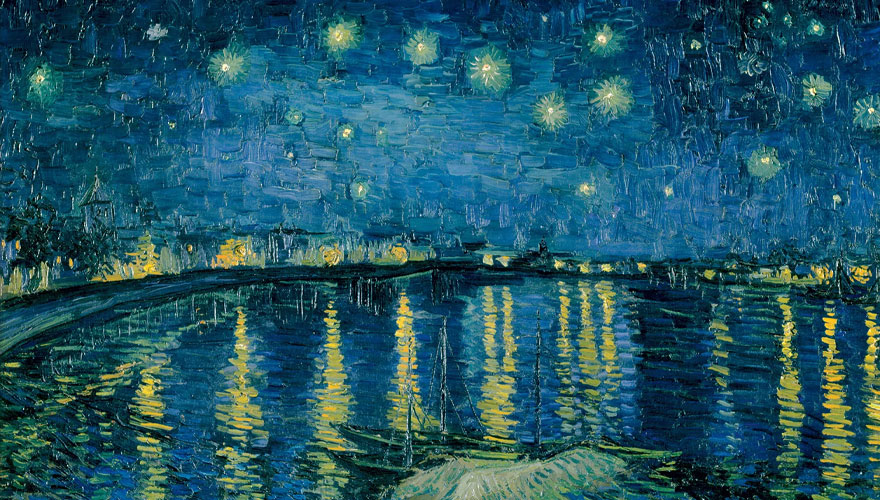
History of Landscape Painting: Nature and Architecture in Focus
Landscape painting focuses on scenes from nature and urban spaces. In contrast to many other pictorial themes, humans play little to no role here, at best a very subordinate one. Landscape painting has been a popular genre for many centuries. Despite many stylistic changes and new trends in the visual arts, it has managed to remain popular to this day.
In the history of art, landscape painting is considered a relatively young genre. For a long time, landscapes served primarily as a background for people and their actions. It was not until around the 17th century that it gradually developed into an independent subject. Since then, various focal points have developed in the pictorial themes: Popular motifs include natural landscapes such as mountains, forests, or fields, as well as artificially created parks or gardens. The genre also includes seascapes such as impressions of the sea, beaches, harbours, or lakes. Human-created cultural landscapes are also included. These can be either entire towns or villages, as well as individual buildings such as churches, houses or even factories.

Development of Landscape Painting: Origins in Antiquity
The history of European landscape painting traces back to antiquity. Mural paintings depicting flora and fauna as well as topographies are known from the Roman Empire and Greece of that epoch. However, these ancient landscape paintings were still very different from the landscape paintings we know today. Often, they merely suggested nature, were highly stylised and lacked detail. This form of depiction was to continue for many centuries.
It was not until the beginning of the Renaissance that artists started to incorporate realistic depictions of nature into their works. Essentially, they continued to limit the role of landscapes to serve as backgrounds for scenes with people. Even during this phase, however, a few painters dared to place nature centre stage and paint pictures without any people at all. Albrecht Altdorfer, for example, created the painting "Danubian Landscape with Wörth Castle" around 1522, and Albrecht Dürer also painted a series of watercolours with motifs from Nuremberg around the year 1500. However, these works were to remain the exception for the time being.
| The evolution of landscape painting into an independent subject was very slow. and it took until the 17th century for it to become fully recognised. |
From the 17th Century Onwards, Landscapes Became an Independent Subject
From the 17th century onwards, the art of landscape painting made significant progress towards becoming an independent genre. In the Netherlands, in particular, it gained popularity among artists and the public during this period. Many painters who are still well-known today, such as Peter Paul Rubens and Rembrandt van Rijn, began dedicating themselves to landscape painting.
The triumph of landscape painting continued throughout Europe in the 18th century. The Romantic epoch provided the ideal environment for all forms of landscape depiction. Its followers saw nature as a mirror of human emotions and the source of passion. This philosophy was also taken up by several painters. William Turner, John Constable, and Caspar David Friedrich created extravagant and opulent scenes where nature was given far more significance and symbolism than human beings.
Even though the compositions were often products of the artists' imagination, they strived for a realistic representation of their subjects. This changed significantly with Impressionism in the 19th century. Impressionist painters no longer sought to depict their surroundings as realistically as possible. Instead, they aimed to depict their subjective impressions of the atmosphere of a single moment in their works.
With Impressionism, a new style of painting became increasingly popular: plein-air painting. In order to transfer their perceptions as unadulterated and direct as possible onto the canvas, artists took their easels and paintings out into nature and worked in the open air.

The History of Landscape Painting in the 20th Century
Interest in landscape painting remained high in the 20th century. Around the turn of the century, many Expressionists such as Emil Nolde, Ernst Ludwig Kirchner, Gabriele Münter and Paula Modersohn-Becker devoted themselves to this genre. In their imagery, they moved even further away from a realistic style of representation. The expressionists no longer imitated nature but aimed to express their emotional world. To achieve this, they worked with bold colours applied in large areas and highly stylised pictorial objects with few details.
Landscapes were also popular among the surrealist artists from the 1920s onwards. Their focus was also not on depicting nature. Instead, they painted fictional scenes with fantastic and dream-like compositions.
After the Second World War, however, landscape painting briefly lost some of its importance in the 20th century. During this phase, painting styles gained popularity in which concrete pictorial objects played no role. These included Abstract Expressionism, Informalism and Action Painting. Even in Pop Art, landscape depictions were rather rare. Here, the focus was primarily on everyday objects, comics, and celebrities. Nevertheless, there were some artists, such as Alex Katz or David Hockney, who continued to paint scenes from nature.
Today, landscape painting is once again part of the repertoire of many artists. Contemporary artists use a full range of styles and present very contemporary interpretations of this traditional genre.
Famous Paintings from the History of Landscape Painting
The great importance of landscape painting in history can easily be seen from the fact that a large number of particularly popular, well-known and, not least, expensive works belong to this genre.
Some "classics" of landscape painting date back to the early 19th century. In 1835, William Turner painted an impressive impression of Venice with "Canal Grande". Caspar David Friedrich's "The Wanderer above the Sea of Fog" still symbolises Romanticism today and Hokusai's "The Great Wave off Kanagawa" is probably one of the most frequently reproduced works of all time.
Many of today's world-famous landscape paintings originate from the late 19th century: Claude Monet's "Impression, Sunrise" gave its name to an entire epoch. Over 100 million US dollars were paid for Paul Cézanne's "Montagne Sainte-Victoire", Gustav Klimt's "Birch Forest" and Claude Monet's "Les Meules", and Vincent van Gogh created his masterpiece "Starry Night over the Rhône". Claude Monet's "Japanese Bridge" and his numerous water lilies are equally renowned.
Numerous other well-known landscape paintings date from the classical modern period, for example, Emil Nolde's atmospheric seascapes, Max Pechstein's harbour views, Edvard Munch's winter landscapes and Ernst Ludwig Kirchner's impressions of the Swiss Alps. Even in the 20th century, famous artists such as Gerhard Richter, Georg Baselitz and Salvador Dalí worked with landscape painting.
